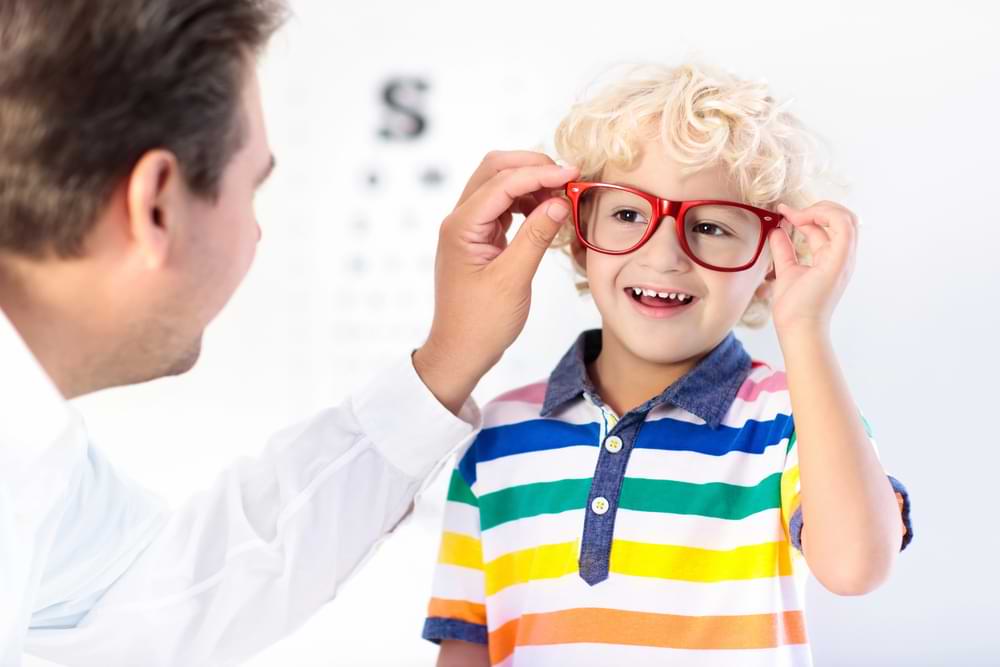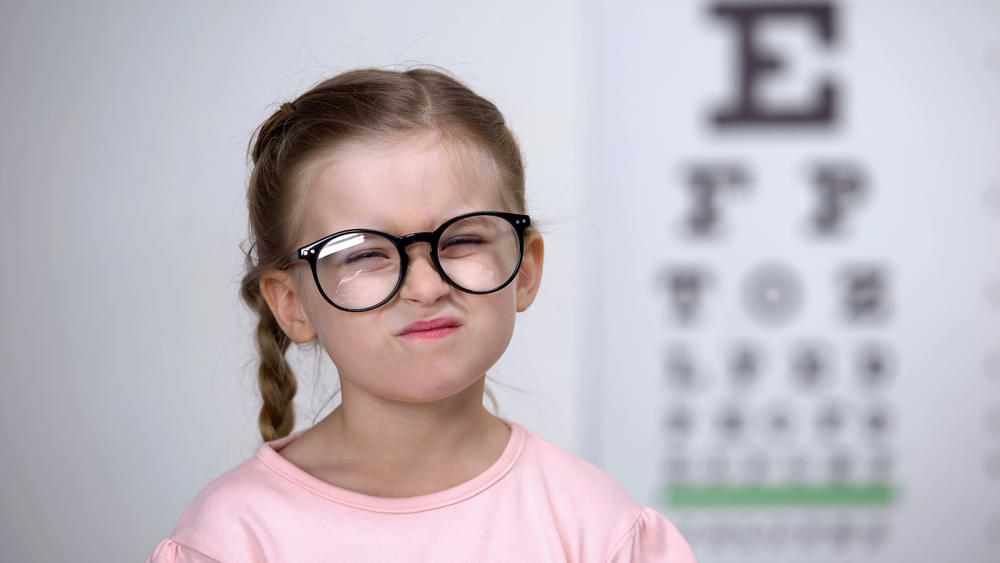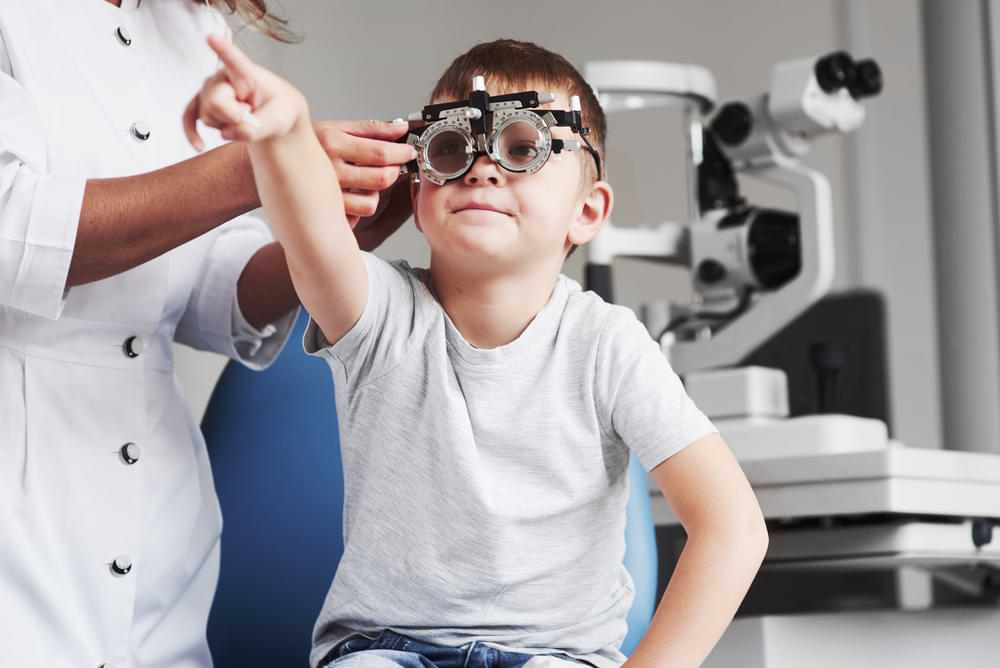Children’s Eye Exams in Melbourne

How important are regular children’s eye exams for your child’s development? Did you know that one in five children has an undetected vision problem? Children don’t always know or can’t always express when they have eyesight issues. Furthermore, not all vision problems are easily noticeable; some can go undetected without regular kid’s eye tests.
I’m Minh Van Tran, the owner and principal optometrist at VisionPro Optometrists. With over two decades of experience in eye care, I’ve dedicated my career to ensuring that children receive the best possible vision care. I understand the concerns parents have about their child’s eye health, and I’m here to provide you with expert advice and compassionate care. Your child’s vision is my priority, and I’m committed to helping them see the world clearly.
Proactive eye exams can safeguard your child’s future by addressing vision problems before they become severe. But failing to address vision problems early can result in long-term damage and more complex treatments later.
Continue reading to find out how you can protect your child’s vision and ensure their success. Or alternatively, take the first step in safeguarding your child’s eye health by booking a consultation with us today.
KEY TAKEAWAYS
- Regular children’s eye exams are crucial for detecting vision problems early.
- Signs that may indicate a need for an earlier exam include eye rubbing, frequent blinking, headaches, tired eyes, and poor school performance.
- Children’s eye exams assess visual acuity, eye alignment, movement, color vision, and overall eye health.
- Common vision problems in children include myopia, hyperopia, astigmatism, amblyopia, and strabismus.
- Vision problems can significantly affect learning and development.
When to Schedule Your Child’s Eye Exams
Why is it important to know when to schedule your child’s eye exams? Regular eye exams are essential to ensure your child’s vision is developing correctly. For optimal eye health, the first eye exam should be at six months old. This initial check-up helps to detect any early signs of vision issues. Following this, another exam is recommended at the age of three. This is a crucial period where any developing issues can be identified and addressed promptly.
As your child approaches school age, around five to six years old, another eye exam is necessary. This check-up ensures that their vision is in good shape for the demands of school, where clear vision is vital for learning and development. If there are no symptoms or identified issues, annual eye exams are sufficient to monitor and maintain your child’s eye health.
However, certain signs may indicate that your child needs an eye exam sooner. If your child frequently rubs their eyes or blinks excessively, this could be a sign of vision problems. Complaints of headaches or tired eyes, particularly after reading or using screens, are also red flags. Poor performance in school, difficulties with reading, or holding books and objects very close to their face are additional indicators that an eye exam is needed promptly.
Regular children’s eye exams play a critical role in your child’s overall health and development. They help to catch any issues early, making treatment easier and more effective.

What to Expect During a Children’s Eye Exam
How can you ensure your child’s eye exam is a positive experience? Understanding what to expect can make the process smoother for both you and your child. A comprehensive children’s eye exam includes several components designed to assess various aspects of vision and eye health.
Firstly, visual acuity tests are conducted. For younger children who might not yet know their letters, we use symbols and pictures to make the test engaging and easy to understand. This helps us determine how clearly your child can see at different distances.
Next, we examine eye alignment and movement. This involves checking how well your child’s eyes work together and whether they are properly aligned. Problems in this area can affect depth perception and reading ability. We also conduct colour vision tests to ensure your child can distinguish different colours correctly, which is important for many daily activities and school tasks.
A thorough ocular health assessment is also performed. This includes checking the health of the eye’s exterior and interior structures to identify any potential issues like infections or congenital conditions.
We strive to make eye exams child-friendly by using engaging and non-intimidating techniques. Our goal is to create a comfortable environment where children feel at ease. Parents are encouraged to be involved during the exam, providing reassurance and support to their child. This involvement can also help parents understand the findings and any recommendations we might make.
If you’d like to learn more about the special approaches optometrists take to children’s eye exams, watch the following video where an optometrist examines a two and a half year old child.
Common Vision Problems in Children
What are the most common vision problems in children, and how can they affect your child’s life? Understanding these issues can help you recognise symptoms early and seek appropriate care. The most frequent vision problems in children include myopia, hyperopia, astigmatism, amblyopia, and strabismus.
Myopia, or short-sightedness, means that distant objects appear blurry while close objects can be seen clearly. It’s caused by the eye growing too long from front to back. Symptoms include squinting, difficulty seeing the board at school, and sitting too close to the TV. Treatment options include prescription glasses, contact lenses, and encouraging outdoor activities to slow the progression.
Hyperopia, or long-sightedness, is when close objects are blurry while distant objects are clear. This occurs when the eye is too short. Children with hyperopia might have trouble reading or doing close-up tasks. Glasses and contact lenses are common treatments to help children see clearly at all distances.
Astigmatism is another common issue where the eye’s surface is irregularly shaped, causing blurred vision at all distances. Children with astigmatism might complain of headaches, eye strain, or distorted vision. Corrective lenses can effectively address this condition, providing clear and comfortable vision.
Amblyopia, often referred to as lazy eye, is when one eye is weaker than the other. This condition can develop if the brain starts to favour one eye over the other, leading to poor vision in the weaker eye. Symptoms include poor depth perception and squinting or closing one eye. Treatment options include patching the stronger eye to force the use of the weaker eye, glasses, and eye exercises.
Strabismus, or crossed eyes, occurs when the eyes do not align properly. One eye may turn in, out, up, or down while the other eye looks straight ahead. This misalignment can lead to amblyopia if untreated. Symptoms include double vision and poor depth perception. Treatments range from glasses and eye exercises to surgery, depending on the severity of the condition.
Understanding these common vision problems can help you identify potential issues early. Early detection and treatment are crucial for preventing long-term vision problems and ensuring your child’s visual development progresses healthily.
Read our in-depth article on Lazy Eye Treatment
Tips for Maintaining Your Child’s Eye Health
How can you keep your child’s eyes healthy and strong? Ensuring good eye health involves a combination of regular check-ups, proper eyewear, and healthy lifestyle habits.
Regular eye exams are fundamental. These check-ups help detect any vision problems early, making treatment more effective. Make sure to follow the recommended schedule for eye exams based on your child’s age and any specific needs they might have.
Wearing prescribed glasses or contact lenses is crucial for children who need them. Ensure your child understands the importance of wearing their glasses consistently to correct vision problems and prevent further issues. Proper care and cleaning of eyewear are also essential to maintain clear vision and eye health.
Protecting your child’s eyes from UV light is another important step. Encourage them to wear sunglasses with UV protection when outdoors. This helps prevent damage from harmful rays, which can contribute to long-term eye issues.
Encouraging outdoor activities benefits eye health. Studies have shown that spending time outside can reduce the risk of developing myopia. Activities like playing sports or simply exploring nature can be both fun and beneficial for your child’s vision.
Nutrition also plays a key role in maintaining eye health. Ensure your child’s diet includes foods rich in vitamins and nutrients important for vision, such as vitamin A, C, and E, as well as omega-3 fatty acids. Foods like carrots, leafy greens, and fish are excellent choices.

Understanding and Addressing Myopia
What exactly is myopia, and why is it a growing concern for children? Myopia, commonly known as short-sightedness, occurs when the eye is too long, causing distant objects to appear blurry while close objects remain clear. This condition is increasingly prevalent among children, largely due to lifestyle changes such as increased screen time and reduced outdoor activities.
The causes of myopia are multifaceted. Genetics play a significant role; if one or both parents are myopic, their children are more likely to develop the condition. Environmental factors are also critical. Prolonged near tasks, like reading or using digital devices, can contribute to the elongation of the eye.
Early detection of myopia is vital. Regular eye exams can identify the condition before it progresses, allowing for timely intervention. Symptoms to watch for include squinting, difficulty seeing distant objects, and holding books or screens very close to the face.
Special myopia control glasses for children with myopia can both correct for vision errors and slow down the progression of myopia. New lens products such as MiyoSmart by HOYA, a Japanese company, have been clinically proven to reduce the progress of myopia through innovative designs.
Another treatment option is orthokeratology (ortho-k), where children wear specially designed contact lenses overnight to reshape the cornea temporarily, and multifocal contact lenses, which can also help control the progression of myopia.
In addition to these eyewear approaches, encouraging children to spend more time outdoors has been shown to slow the progression of myopia. Activities like playing sports or simply exploring nature can be beneficial.
Addressing myopia early and effectively can help mitigate long-term risks, such as the development of high myopia, which increases the likelihood of serious eye conditions like retinal detachment or glaucoma. Regular monitoring and adopting a proactive approach to children’s eye exams can significantly improve outcomes for children with myopia.
How Vision Problems Affect Learning and Development
Do vision problems impact your child’s learning and development? Absolutely. Clear vision is essential for academic success and overall development. When children have undiagnosed vision issues, they may struggle with reading, writing, and other classroom activities, which can lead to poor academic performance and frustration.
Children with vision problems often exhibit signs that can be mistaken for learning disabilities or behavioural issues. For instance, they might have difficulty concentrating, frequently lose their place while reading, or avoid close-up tasks altogether. These issues can affect their confidence and willingness to participate in school activities.
Early diagnosis and treatment are crucial in preventing these problems from interfering with your child’s education. Regular eye exams can detect vision issues that might otherwise go unnoticed. Once identified, appropriate interventions, such as glasses or vision therapy, can significantly improve a child’s ability to learn and engage in the classroom.
Collaboration with teachers and school staff is also important. By informing them of your child’s vision condition, they can provide necessary accommodations and support. This might include seating arrangements, extra time for tasks, or using larger print materials to aid reading.
When to Seek a Paediatric Optometrist
When should you consider taking your child to a paediatric optometrist? Specialised eye care for children is essential to address their unique vision needs. Paediatric optometrists have advanced training and experience in managing and treating eye conditions specific to children.
You should seek a paediatric optometrist if you notice signs of vision problems that require specialised attention. These signs include persistent eye rubbing, squinting, difficulty reading, or complaints of headaches and eye strain. Early and regular check-ups with a paediatric optometrist can help detect and treat issues before they impact your child’s development.
Paediatric optometrists offer comprehensive care that goes beyond basic eye exams. They use child-friendly techniques and equipment designed to make the experience comfortable and stress-free. Their expertise ensures accurate diagnosis and effective treatment tailored to children’s needs.
Scheduling an appointment with a paediatric optometrist is particularly important if your child has a family history of eye conditions. Early detection of hereditary issues can prevent long-term complications. Moreover, children with special needs or developmental delays may benefit significantly from the specialised care provided by a paediatric optometrist.
Preparing for your child’s visit is key to a successful and smooth experience. Explain to your child what to expect during the exam to alleviate any anxiety. Bringing a favourite toy or book can also help keep them calm and engaged.
In summary, seeking a paediatric optometrist for your child’s eye care ensures they receive the best possible attention for their vision needs. This proactive approach helps maintain healthy vision and supports your child’s overall development and well-being.
Final Thoughts
Regular eye exams are essential for detecting and treating vision problems early, ensuring your child’s healthy development. Optometrists use child-friendly techniques to ensure comprehensive and comfortable eye exams tailored to your child’s needs.
However, undetected eye issues may cause your child to struggle in school, affecting their academic performance and confidence.
Be proactive about your child’s well-being—contact us today to set up a comprehensive eye exam.
Scheduling an eye exam appointment is simple and straight forward.
You can call us on (03) 9687 8787 for Footscray, (03) 9364 5509 for St Albans, (03) 9600 1142 for Sunshine OR arrange an appointment using the “Book An Appointment” button in the navigation menu. All our practices are easily accessible, with nearby parking and public transport options available.

Minh gained his Bachelor of Optometry in 2000, and his Certificate in Ocular Therapeutics (ACO) in 2016.
He started VisionPro Optometrists in 2008 and has been Principal Optometrist ever since, working in both the Footscray and the St Albans practices.
Minh is a member of Optometrist Association Australia and the ACO. He always strives to achieve the highest standard of professionalism when delivering eyecare to all his patients.
Minh’s special areas of interest include ocular diseases and management, children’s vision and contact lens fitting. Minh enjoys travelling and reading in his spare time.
